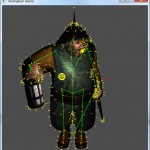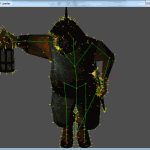In this article I will demonstrate how to apply 2D textures to your 3D models. I will also show how to define lights that are used to illuminate the objects in your scene.
I assume that the reader has a basic knowledge of C++ and how to create and compile C++ programs. If you have never created an OpenGL program, then I suggest that you read my previous article titled [Introduction to OpenGL and GLSL] before continuing with this article.
Category Archives: OpenGL
Using OpenGL Vertex Buffer Objects
If you are not sure how to use extensions in OpenGL, you can refer to my previous article titled OpenGL Extensions. If you have never programmed an OpenGL application before, you can refer to my previous article titled Introduction to OpenGL.
GPU Skinning of MD5 Models in OpenGL and Cg
This tutorial builds upon the previous article titled [Loading and Animating MD5 Models with OpenGL]. It is highly recommended that you read the previous article before following this one. In this tutorial, I will extend the MD5 model rendering to provide support for GPU skinning. I will also provide an example shader that will perform the vertex skinning in the vertex shader and do per-fragment lighting on the model using a single point light. For a complete discussion on lighting in CgFX, you can refer to my previous article titled [Transformation and Lighting in Cg].
Continue reading
Loading and Animating MD5 Models with OpenGL
In this article, I will show how you can load and animate models loaded from the MD5 model file format. In this article I will use OpenGL to render the models. I will not show how to setup an OpenGL application in this article. If you need to get a quick introduction on setting up an OpenGVL application, you can follow the “Beginning OpenGL for Game Programmers” article [here].




